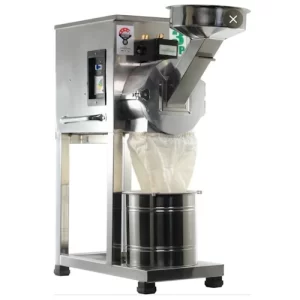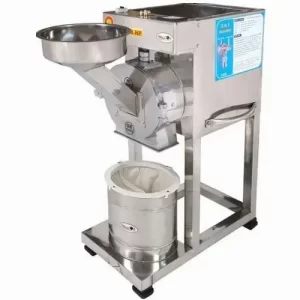Food Pulverizer Machine
-
Double Stage Pulverizer Machine, 30 Kg/hr
Capacity 30 Kg/hrMotor Power 3 HPOperation Mode Automatic₹16,000.00Double Stage Pulverizer Machine, 30 Kg/hr
₹16,000.00 -
7.5 HP MS Pulverizer Machine
Material Mild SteelUsage/Application CommercialMotor Type 7.5 HP₹97,000.007.5 HP MS Pulverizer Machine
₹97,000.00 -
3 Hp Stainless Steel Pulverizer Machine
Capacity 30 kg/hFrequency 50 HzMachine Rpm 2880 RPM₹17,000.003 Hp Stainless Steel Pulverizer Machine
₹17,000.00 -
3 Hp 2 In 1 Pulverizer Machine
Machine Capacity 50 kg/hourMaterial Stainless SteelUsage/Application Commercial₹16,500.003 Hp 2 In 1 Pulverizer Machine
₹16,500.00 -
2 Hp SS Pulverizer Machine, Commercial
Capacity 12 TO 15 KG PER HOURUsage/Application DOMESTIC AND COMMERCIAL USE₹10,900.002 Hp SS Pulverizer Machine, Commercial
₹10,900.00 -
2 Hp SS Pulverizer Machine
Model Name/Number 2HP PULVERIZERApplication GrindingPower 2 hp₹12,500.002 Hp SS Pulverizer Machine
₹12,500.00 -
Automatic 3 HP Ms Pulverizer Machine
Capacity 20-25 kg/hrMotor Power 3 HPPower Consumption 2.5 Kwh₹25,999.00Automatic 3 HP Ms Pulverizer Machine
₹25,999.00 -
Food Pulverizer Machine
Material Stainless SteelUsage/Application FOR MANUFACTURER OF GRINDINGBrand Rising₹36,000.00Food Pulverizer Machine
₹36,000.00
Food Pulverizer Machine: The Ultimate Guide for Your Kitchen or Business
A food pulverizer machine is an essential tool for anyone involved in food processing, whether you’re operating a small kitchen, a restaurant, or a large-scale food production facility. This versatile machine can efficiently grind, crush, and pulverize various food items into fine powders, making it easier to prepare ingredients for cooking or baking. In this comprehensive guide, we will delve into the features, benefits, types, and frequently asked questions about food pulverizer machines to help you make an informed decision for your culinary needs.
What is a Food Pulverizer Machine?
A food pulverizer machine is designed to reduce the size of food particles into fine powders or granules. It utilizes various mechanisms such as blades, hammers, and screens to achieve the desired consistency. These machines are commonly used for grinding spices, grains, herbs, and other ingredients that require fine milling.
Key Features of Food Pulverizer Machines
- Versatile Grinding Options: Food pulverizers can handle a wide range of materials, including grains, spices, nuts, and dried fruits.
- Durable Construction: Most food pulverizers are made from high-quality stainless steel or food-grade materials that ensure durability and hygiene.
- Adjustable Settings: Many models come with adjustable settings that allow you to control the fineness of the grind according to your requirements.
- High Capacity: Food pulverizers are available in various sizes and capacities to meet different production needs—from small home kitchens to large commercial operations.
- Easy Operation: Most machines are designed for user-friendly operation, allowing even novice users to achieve professional results.
Benefits of Using a Food Pulverizer Machine
1. Time Efficiency
One of the primary advantages of using a food pulverizer machine is the significant reduction in preparation time. Grinding ingredients manually can be labor-intensive and time-consuming. A pulverizer can quickly produce fine powders in a matter of minutes.
2. Consistency in Texture
Achieving a uniform texture when grinding ingredients manually can be challenging. A food pulverizer ensures that all particles are ground to the same size, resulting in consistent texture and flavor in your dishes.
3. Versatility
Food pulverizers can be used for various applications beyond just grinding spices or grains. They can also be used for making flour, powdered sugar, nut butters, and more.
4. Improved Quality
The ability to grind fresh ingredients means you can enhance the quality of your dishes significantly. Freshly ground spices and herbs offer superior flavor compared to pre-packaged options.
5. Cost-Effective
Investing in a food pulverizer machine can save you money in the long run by allowing you to buy ingredients in bulk and process them yourself rather than purchasing pre-ground products.
Types of Food Pulverizer Machines
When selecting a food pulverizer machine for your kitchen or business, consider the following types:
1. Hammer Mill Pulverizers
Hammer mills use rotating hammers to crush and grind materials into fine particles. They are ideal for grinding hard materials like grains and spices.
2. Pin Mill Pulverizers
Pin mills utilize sharp pins to create friction that grinds materials into fine powders. They are suitable for grinding soft to medium-hard materials such as sugar and dried fruits.
3. Impact Pulverizers
Impact pulverizers use high-speed impact forces to break down materials into fine particles. They are effective for grinding spices, herbs, and other soft materials.
4. Cryogenic Pulverizers
These specialized machines use extremely low temperatures to freeze materials before grinding them into fine powders. They are commonly used for sensitive materials like rubber or certain plastics but can also be applied in food processing.
5. Commercial Food Pulverizers
Designed for heavy-duty use in restaurants or food production facilities, commercial food pulverizers often have larger capacities and more robust construction compared to home models.
How to Choose the Right Food Pulverizer Machine
Selecting the right food pulverizer machine depends on several factors:
- Material Type: Determine what types of materials you will be grinding most frequently (e.g., spices, grains) to choose an appropriate model.
- Production Volume: Assess how much material you need to process at once; larger capacities may be necessary for commercial use.
- Budget: Set a budget that aligns with your needs while considering long-term value versus initial cost.
- Space Availability: Measure your kitchen space to ensure that the machine fits comfortably without obstructing movement.
- Ease of Cleaning: Look for models with easy disassembly and cleaning features to maintain hygiene standards.
Frequently Asked Questions (FAQ)
1. What materials can I grind with a food pulverizer machine?
Food pulverizers can handle various materials including grains (wheat, rice), spices (pepper, cumin), nuts (almonds, peanuts), dried fruits (raisins), and even herbs (basil, oregano).
2. How long does it take to grind ingredients with a food pulverizer?
The time required depends on the type of material being ground and the desired fineness; however, most machines can produce finely ground powders within minutes.
3. Are there any safety precautions I should take when using a food pulverizer?
Always follow the manufacturer’s instructions regarding operation and maintenance; ensure that the machine is properly assembled before use and avoid overloading it with too much material at once.
4. Can I grind wet ingredients with a food pulverizer?
Most standard food pulverizers are designed for dry ingredients; however, some models may handle wet grinding if specified by the manufacturer—check your model’s guidelines before attempting.
5. How do I clean my food pulverizer machine?
To clean your machine:
- Unplug it before cleaning.
- Disassemble removable parts.
- Use warm soapy water or a damp cloth to wipe down surfaces.
- Rinse thoroughly and allow all parts to dry completely before reassembling.
6. What is the average cost of a food pulverizer machine?
Prices vary widely based on features and capacity but generally range from $100 for small home models to several thousand dollars for industrial-grade machines.
7. Where can I buy a food pulverizer machine?
You can purchase food pulverizer machines from various online retailers specializing in kitchen equipment or directly from manufacturers’ websites.
8. Do I need special training to operate a food pulverizer machine?
Most models are designed for ease of use; however, basic training may be beneficial if you’re using a complex industrial model.
Conclusion
A food pulverizer machine is an invaluable asset for anyone involved in cooking or food processing—be it at home or in commercial settings like restaurants or catering services. With their ability to streamline ingredient preparation while maintaining quality and consistency, these machines cater perfectly to both small-scale operations and large-scale businesses alike.








